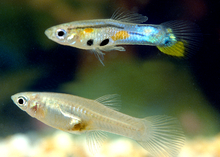Oropuche guppy
| Oropuche guppy | ||||||||||||
|---|---|---|---|---|---|---|---|---|---|---|---|---|
| Systematics | ||||||||||||
|
||||||||||||
| Scientific name | ||||||||||||
| Poecilia obscura | ||||||||||||
| Schories , Meyer & Schartl , 2009 |

The oropuche guppy ( Poecilia obscura ) is a freshwater fish from the group of viviparous toothcarps (Poeciliinae). The species was only described in 2009 . The separation from the common guppy ( Poecilia reticulata ) was mainly due to differences in the DNA sequences .
distribution
The Oropuche guppy lives in northeastern Trinidad and there only the catchment area of the Oropuche River and a few watercourses that flow independently into the Atlantic. The common guppy is found in most of the island, only in the extreme northwest there are no species of guppy in the rivers and streams. The range of the oropuche guppy is isolated by mountains and ridges.
features
The oropuche guppy can hardly be distinguished from the common guppy in appearance. Like this one he shows a clear sexual dimorphism . The females are larger than male oropuche guppies and reach lengths of about 3 cm. They are simply grayish-beige in color and strongly built. Sexually mature females have a clearly recognizable gestation mark. The fins are not taken off.
Male oropuche guppies do not grow to be more than 2 cm long. As with the common guppy, some of the dorsal and caudal fin rays may be elongated. They are also colorfully patterned with all kinds of spots and ribbons.
In the oropuche guppy, the dorsal fin is supported by 6 fin rays, the number of fin rays in the other fins has not been determined. In males, the anal fin is transformed into a mating organ, the gonopodium . The first two anal fin rays are short, the third, fourth and fifth are elongated and form a channel for sperm transfer, the fin rays 6, 7, 8 and 9 are shortened. The number of spines arranged like a comb on the third fin ray of the gonopodium is 11 to 15, while in the common guppy and in Endler's guppy it is 14 to 18. In addition, their base is strong, while the other two species of guppies are slim.
The tail stalk of the females is short and only 4.8 to 6.15 mm long, while it can be 6.5 to 7.3 mm long in the common guppy and Endler's guppy. The head length is 25.5 to 26.5% of the standard length . In a longitudinal row one counts 25, less often 24 scales and 12 to 13 on the midline in front of the dorsal fin. The number of vertebrae is from 24 to 25.
literature
- Susanne Schories, Manfred K. Meyer & Manfred Schartl: Description of Poecilia (Acanthophacelus) obscura n. Sp., (Teleostei: Poeciliidae), a new guppy species from western Trinidad, with remarks on P. wingei and the status of the “Endler's guppy". Zootaxa 2266: 35-50 (2009) PDF
- Michael Kempkes: The guppies. Neue Brehm-Bücherei Vol. 662, Westarp Sciences, Hohenwarsleben, 2010, ISBN 978-3-89432-875-7
Web links
- Oropuche-Guppy on Fishbase.org (English)
